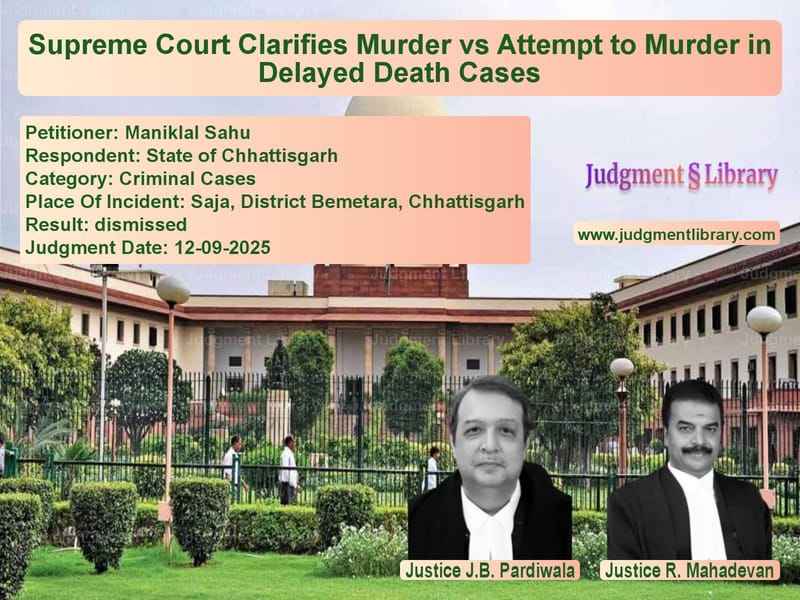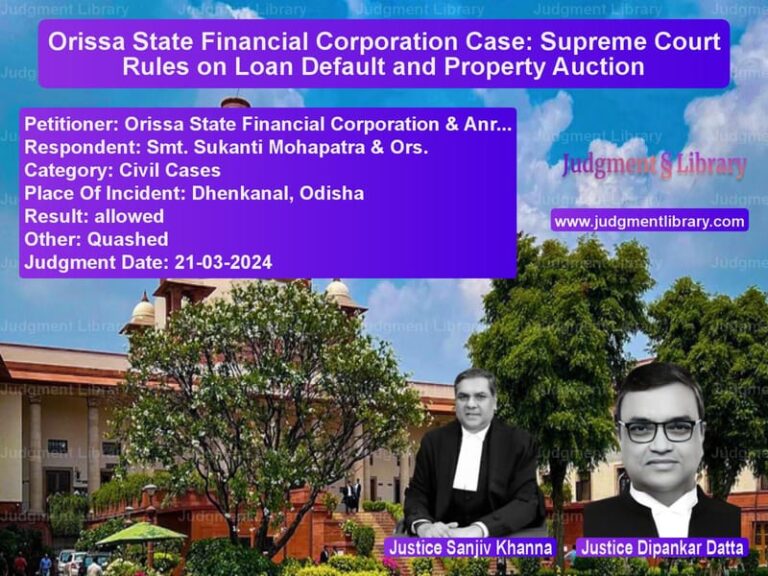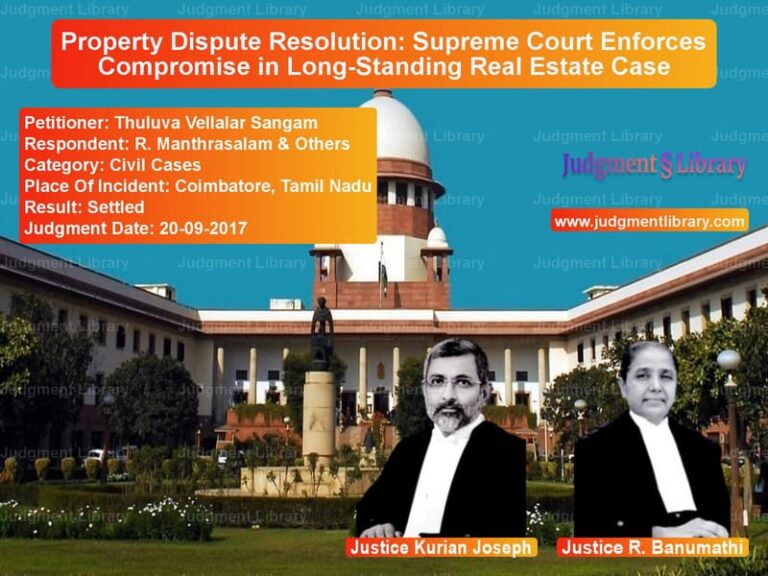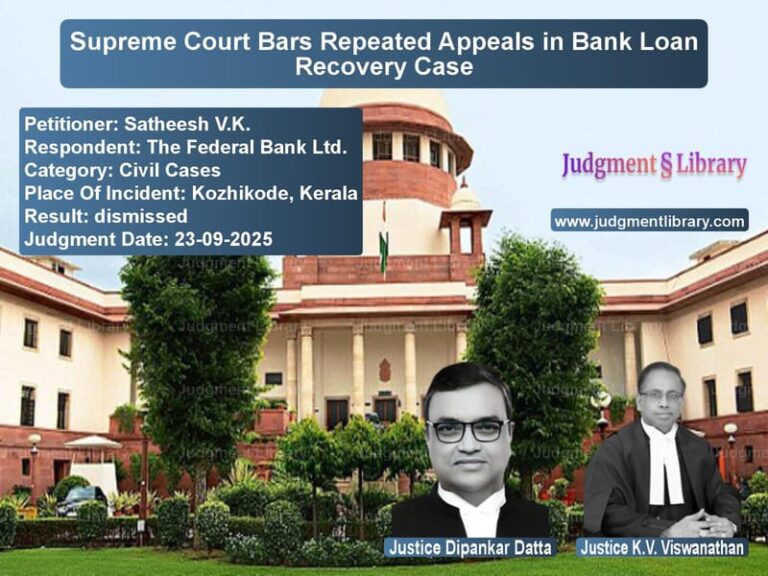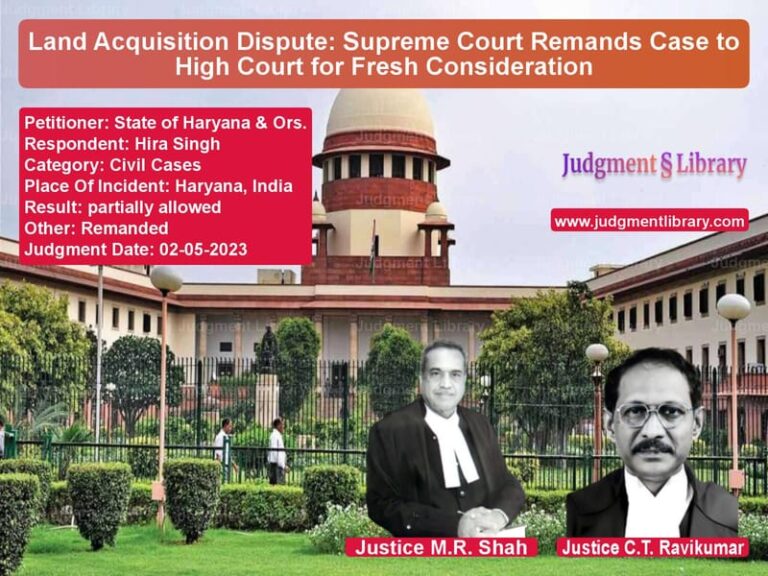Supreme Court Clarifies Murder vs Attempt to Murder in Delayed Death Cases
In a significant criminal law judgment, the Supreme Court of India recently addressed the complex legal question of when an offense should be classified as murder versus attempt to murder when death occurs after a considerable time delay from the original assault. The case involved Maniklal Sahu, who along with three co-accused, was convicted for the fatal assault on Rekhchand Verma in Chhattisgarh.
The tragic incident occurred on February 22, 2022, when the appellant along with three others trespassed into the house of the deceased, dragged him to the terrace, and flung him down. After the victim fell from the terrace, the assailants further assaulted him with sticks and fisticuffs. The injured Rekhchand Verma was shifted to the hospital in critical condition and survived for about nine months before ultimately succumbing to his injuries on November 8, 2022.
The Legal Journey
The trial court convicted all four accused under Section 302 of the Indian Penal Code (murder) and sentenced them to life imprisonment. However, the Chhattisgarh High Court, in its judgment dated July 30, 2024, altered the conviction from Section 302 IPC to Section 307 IPC (attempt to murder) and sentenced them to seven years of rigorous imprisonment. The High Court’s reasoning centered on the fact that the victim had survived for nine months and died due to complications during treatment rather than directly from the injuries.
Read also: https://judgmentlibrary.com/supreme-court-upholds-liberty-principles-in-anticipatory-bail-case/
Maniklal Sahu then approached the Supreme Court, arguing that he should be acquitted of all charges. His counsel vehemently submitted that “the cause of death has no nexus with the injuries suffered by the deceased at the time of the alleged assault on him.” The appellant’s second argument was that “the eyewitnesses are not reliable witnesses. They are interested witnesses being PW-1 Satish Verma, brother of the deceased; PW-11 Vikas Verma, another brother of the deceased; and PW-12 Gautahiri Bai Verma, mother of the deceased. It was argued that they had no occasion to witness the alleged assault.”
The State of Chhattisgarh, while opposing the appeal, took the position that the High Court had committed a serious error in altering the conviction from murder to attempt to murder. However, since the State had not preferred any acquittal appeal, they requested that the conviction under Section 307 IPC be maintained.
Medical Evidence and Cause of Death
The Supreme Court carefully examined the medical evidence presented by three doctors. Dr. Sheetal Kaushal (PW-9) had examined the victim immediately after the incident and found him in a semi-conscious state with a serious head injury bleeding profusely. Dr. Twinkle Chandrakar (PW-24), who treated the victim at Shankaracharya Hospital, testified that the deceased died due to “Septic shock with bilateral pneumonia with post traumatic spinal cord injury with paraplegia with infected bedsore with hepatic dysfunction.”
Dr. Abhishek Shrivastava (PW-28), who conducted the postmortem, stated that “the said deceased died of cardiorespiratory attack due to septic shock, which was caused by infection of the injuries in the body of the deceased.” Importantly, all three medical experts were clear that the death was ultimately attributable to the spinal cord injury sustained during the assault.
The Supreme Court’s Legal Analysis
The Supreme Court, in its detailed judgment, explained the fundamental difference between murder and attempt to murder. Justice J.B. Pardiwala, writing for the bench, emphasized that “the most important ingredient to constitute the offence of attempt to commit murder punishable under Section 307 of the IPC is the intention or knowledge.”
The Court extensively discussed the theory of causation in criminal law, particularly where death ensues after some delay. The judgment noted that “the theory of causation should be kept within reasonable limits at both ends. The question when there are latter complications would be, whether such complications are the natural or likely consequences of the injury, the ordinary course it takes before death causes.”
The Court referred to Explanation 2 to Section 299 IPC, which states: “Where death is caused by bodily injury, the person who causes such bodily injury shall be deemed to have caused the death, although by resorting to proper remedies and skillful treatment the death might have been prevented.”
Addressing the specific circumstances of delayed death, the Court observed: “There can be no stereotypical assumption or formula that where death occurs after a lapse of some time, the injuries (which might have caused the death), the offence is one of culpable homicide. Every case has its unique fact situation. However, what is important is the nature of injury, and whether it is sufficient in the ordinary course to lead to death.”
Key Legal Principles Established
The Supreme Court laid down several important principles that courts must consider in similar cases:
“If it is proved that the injury was fatal and the intention was to cause death, though the death occurred after several days of septicaemia or other complications having supervened, yet it is undoubtedly a murder as it falls within the first limb of Section 300 of the IPC.”
“If it is proved that the injuries by themselves were sufficient to cause death in the ordinary course of nature, and if it is established that those injuries were the intended injuries, though the death might have occurred after septicaemia or other complications had supervened, yet the act of the accused would squarely fall under the third limb of Section 300 of the IPC.”
“In judging whether the injuries inflicted were sufficient in the ordinary course of nature to cause death, the possibility that skilful and efficient medical treatment might prevent the fatal result is wholly irrelevant.”
The Court emphasized that “If the supervening causes are attributable to the injuries caused, then the person inflicting the injuries is liable for causing death, even if death was not the direct result of the injuries.”
Court’s Conclusion on the High Court’s Error
The Supreme Court strongly disagreed with the High Court’s reasoning that the nine-month survival period and treatment complications reduced the offense from murder to attempt to murder. The Court noted: “We are taken by surprise as to on what basis the High Court has recorded a finding that the deceased succumbed to the injuries suffered by him due to lack of proper treatment. There is absolutely no evidence in this regard.”
The judgment further stated: “In the present case, as per the oral testimony of the three doctors referred to above, the cause of death of deceased Rekhchand was cardiorespiratory failure. The injuries suffered by him at the time of assault lead to septic shock with bilateral pneumonia, post traumatic spinal cord injury with paraplegia and infected bedsore hepatic dysfunction. The injuries suffered by the deceased were sufficient in the ordinary course of nature to cause death and would come under clause ‘Thirdly’ of Section 300 of the IPC.”
The Court concluded that “the High Court committed a serious error in bringing the case within the ambit of attempt to commit murder punishable under Section 307 of the IPC on the ground that the victim survived for almost nine months from the date of the incident, and died on account of pneumonia and other complications during the course of treatment and not due to the injuries suffered at the time of assault.”
Final Outcome
Despite finding that the High Court had committed a serious legal error in reducing the conviction from murder to attempt to murder, the Supreme Court noted that the State had not filed any appeal against this reduction. Therefore, while strongly criticizing the High Court’s legal reasoning, the Supreme Court dismissed Maniklal Sahu’s appeal and maintained his conviction under Section 307 IPC with seven years imprisonment.
This judgment serves as an important clarification in criminal jurisprudence, establishing that the time interval between injury and death does not automatically downgrade the offense from murder to attempt to murder. What matters is whether the injuries were sufficient in the ordinary course of nature to cause death, and whether the fatal complications were a natural and probable consequence of the original injuries.
Petitioner Name: Maniklal Sahu.Respondent Name: State of Chhattisgarh.Judgment By: Justice J.B. Pardiwala, Justice R. Mahadevan.Place Of Incident: Saja, District Bemetara, Chhattisgarh.Judgment Date: 12-09-2025.Result: dismissed.
Don’t miss out on the full details! Download the complete judgment in PDF format below and gain valuable insights instantly!
Download Judgment: maniklal-sahu-vs-state-of-chhattisgar-supreme-court-of-india-judgment-dated-12-09-2025.pdf
Directly Download Judgment: Directly download this Judgment
See all petitions in Murder Cases
See all petitions in Attempt to Murder Cases
See all petitions in Judgment by J.B. Pardiwala
See all petitions in Judgment by R. Mahadevan
See all petitions in dismissed
See all petitions in supreme court of India judgments September 2025
See all petitions in 2025 judgments
See all posts in Criminal Cases Category
See all allowed petitions in Criminal Cases Category
See all Dismissed petitions in Criminal Cases Category
See all partially allowed petitions in Criminal Cases Category

